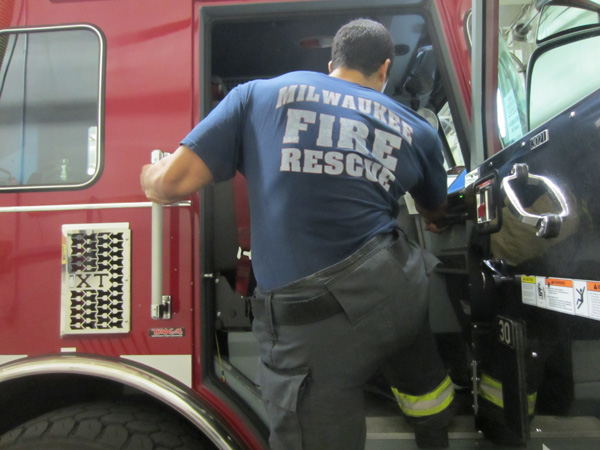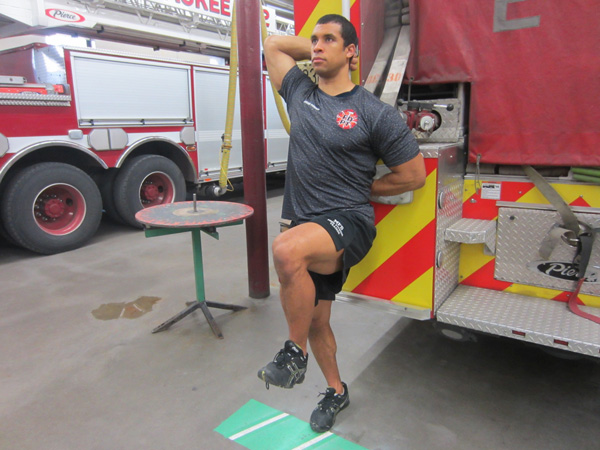

Sponsored content from Paul Conway Fire
By Jordan Ponder
Where’d that pain come from?
“All right, come and get it,” the cook calls. It’s been a great shift and the cook’s putting out your favorite meal. You get up from the recliner and head to the kitchen when the EMS tones sound. Without flinching, you change your path from the kitchen to the rig, focusing your attention to the dispatcher calling over the PA as you put your boots and bunkers on before stepping into the rig. You respond to the call, but as you are doing your patient evaluation, you notice bit of discomfort in your lower back. It feels tight on one side of your spine. Reflecting on the day, you try to think of anything traumatic that would cause you to feel this way. However, nothing significant comes to mind. What could it be? When did this happen?
As firefighters, there are things you do so regularly that they become unconscious. This is not bad, but when poor movements become unconscious, it can lead to pain and/or injury. Unconscious poor movement can be compared to fire seeking the path of least resistance. Similarly, your body wants to travel the easiest way possible regardless of whether it is the safest. A perfect example of this is getting in and out of the rig. We do it all the time, but many have issues that cause them to perform a hip hike in order to step onto the high step. This done continually can lead to back pain. This pain stems from a tight Quadratus Lumborum (QL), weak hip flexors, and weak obliques. Not only is a hip hike very common for firefighters, but it is further exaggerated by wearing your turnout pants, which reduce your ability to lift your knee into the rig. Here, you’ll learn how you can relax your QL, strengthen your hip flexors and obliques to prevent hip hiking, and ultimately prevent lower back pain and injury.
Your QL is located in your lower back and connects the spine to the pelvis. It contracts each time you raise or rotate your hip on one side. Your hip flexors (front of your thighs) and obliques (sides of abdominals close to hips) help stabilize the pelvis performing the opposite functions of your QL. What is needed is a balance between these muscles for healthy movement.
To create this balance, we should address a great technique called Self-Myofascial Release, which calms the muscle allowing you to maximize your time spent stretching. If you are interested in this simple and beneficial technique, e-mail me at jponder@fd-pt.com to learn how to use it to fit your personal needs. In the meantime, you can also use time-efficient static and active stretches to encourage that balance:

Stand next to your rig with a handle bar to your side. Grab the handle bar with the hand that is closest to it then cross your far foot behind the other foot. Drop your hip away from the handle bar reaching the far arm up and over your head. As you are able, grab the handle bar with your far hand to intensify the stretch. If you feel more of a stretch in your larger back muscles and less in your hips, drop your hip lower and bring your far hand down. Hold this position for 30-40 seconds. Switch sides performing this again on both sides.

After you’ve done this, stand with your back to the handle. Hold the handle with your right hand behind your head, and with your left hand behind your lower back. Use the handle as a cue to keep your spine straight by pressing your head and upper and lower back into your hands and the handle. Tuck your pelvis underneath you, keeping your legs straight, standing nice and tall. Pull your left knee up towards your chest, squeezing it for 2-3 seconds at the top as you continue to press into the handle bar and your hands. Keep your stationary foot flat on the ground and your pelvis level as you raise your knee. Contract your abdominals and hip flexors tightly as your leg reaches parallel to the ground. Repeat this six times with the same leg before you switch hands and switch legs and then repeat for another round on each side.
Moving unconsciously is a necessary function for every firefighter. The issue comes when you are moving in a way that causes small, traumatic, degenerative injuries that can leave you in pain or injured. One example of this type of issue comes from hip hiking, which you can address by stretching your QL and strengthening your hip flexors and obliques.
Jordan Ponder is a Captain of the Milwaukee Fire Department assigned to Engine 30. Additionally, he is the Lead Peer Fitness Trainer for the MFD where he has been training firefighter health for over 12 years. Holding NASM-CPT, ACE, PFT and multiple of modality certifications, he is also a professional bodybuilder with the WNBF. Jordan is also the Director of Firefighter Dynamic Performance Training which supplies free safety training equipment for fire departments for conducting workshops for their members. To contact Jordan Ponder, email jponder@fd-pt.com.
As part of injury prevention, ensure that your turnout gear fits correctly and meets proper standards. Learn more about some of the latest gear here.

